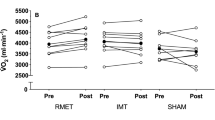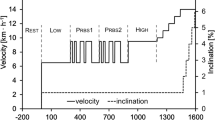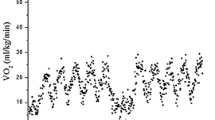Abstract.
We tested whether the increased cycling endurance observed after respiratory muscle training (RMT) in healthy sedentary humans was associated with a training-induced increase in cardiac stroke volume (SV) during exercise, similar to the known effect of endurance training. Thirteen subjects underwent RMT by normocapnic hyperpnea, nine underwent aerobic endurance training (cycling and/or running) and fifteen served as non-training controls. Training comprised 40 sessions performed within 15 weeks, where each session lasted 30 min. RMT increased cycling endurance at 70% maximal aerobic power (\(\dot W_{{\rm max}} \) ) by 24% [mean (SD) 35.6 (11.9) min vs 44.2 (17.6) min, P<0.05], but SV at 60% \(\dot W_{{\rm max}} \) was unchanged [94 (21) ml vs 93 (20) ml]. Aerobic endurance training increased both SV [89 (24) ml vs 104 (32) ml, P<0.01] and cycling endurance [37.4 (12.8) min vs 52.6 (16.9) min, P<0.01]. In the control group, no changes were observed in any of these variables. It is concluded that the increased cycling endurance that is observed after RMT is not due to cardiovascular adaptations, and that the results provide evidence for the role of the respiratory system as an exercise-limitingfactor.
Similar content being viewed by others
Author information
Authors and Affiliations
Additional information
Electronic Publication
Rights and permissions
About this article
Cite this article
Markov, G., Spengler, C.M., Knöpfli-Lenzin, C. et al. Respiratory muscle training increases cycling endurance without affecting cardiovascular responses to exercise. Eur J Appl Physiol 85, 233–239 (2001). https://doi.org/10.1007/s004210100450
Accepted:
Issue Date:
DOI: https://doi.org/10.1007/s004210100450




